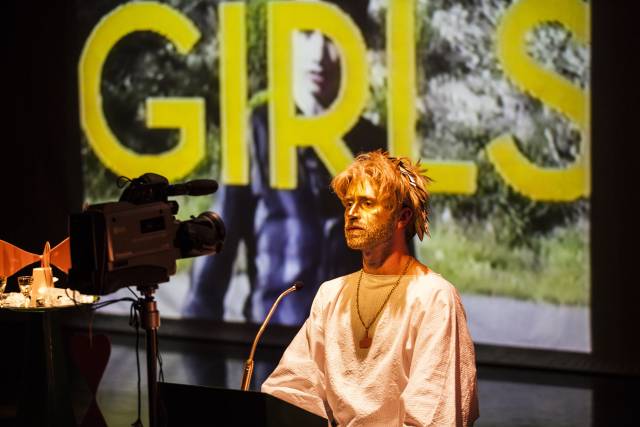

Upon the rupture in his relationship with Paul Verlaine, after Verlaine shot him, the adolescent poet prodigy Arthur Rimbaud declared in his prose poem "Morning of Drunkeness," “Behold the time of the assassins!” Recalling this poem while taking in the multimedia performance piece The Art of Luv (Part 1): Elliot by the Royal Osiris Karaoke Ensemble (ROKE) that line begins to take on a certain novel, almost prophetic resonance.
Except for one quite physical act involving sushi, it doesn’t seem like much is going on in this performance, in much the same way that there wouldn't seem to be much going on were one to observe a person flipping through channels on the television or in the thralls of a YouTube viewing binge. But that this lack of surface action is an illusion masking deeper processes in humanity is one of the main points that Art of Luv manages to convey. Somewhere at the center of the vortex of white noise and fragmented superficiality that so prominently define our widely encompassing sphere of media in these modern times there are human beings who are deeply affected by the blitzkrieg of schizoid messages that daily penetrate their senses.
The ritualistic performance of The Art of Luv (Part 1): Elliot is conducted by the “musical priests” Tei Blow and Sean McElroy. After a brief video introduction presenting the program as a guide to enlightenment and enticing the audience to breathe deeply and listen, a stream of videos begins to play, projected onto a screen above and between the priests in gold face-paint and white robes. These videos are mainly, but not exclusively, self-indulgent instructional videos on dating, relationships, desirability and masculinity. Below this, the priests, sitting at either side under the screen, take turns switching sides and looking into a video camera that projects their faces on either side of the center screen playing the aforementioned videos. The volume drops in and out of the video recording in the center and the priests speak verbatim the dialogue in synch to the lips that spoke them originally. The cornucopia of videos begins to be interspersed with clips, which receive the same treatment from the priests, of the YouTube video diary of Elliot Rodger, which chronicled his lack of success with "girls." On May 23, 2014, Elliot Rodger’s videos would come to signify a path that led to the killing by him of six people in Isla Vista near the University of California campus on a rampage that injured thirteen others.

Through the deconstructive process, ROKE creates a kind of continuity through all the severed messages presented. With deadpan monotone deliveries that are often very funny in their effect, Blow and McElroy, in their dramatic garb, alienate and isolate the lingual signifiers in the videos, making them at once more and less than they are. They draw attention to the shallowness and vanity of what is actually being said, but also to the fact that what is being said reverberates, perhaps more often than not unnoticed, in the consciousness of the recipients of those messages. Through the thread of continuity that they weave, ROKE points towards the dire consequences that this may hold for society.
The only shortcoming of The Art of Luv (Part 1): Elliot is that it doesn’t make clear in the piece itself that Rodger’s gradual and chronicled psychological disfigurement culminated in the tragedy that it did. Knowing this to be the case is what lends The Art of Luv (Part 1) its greatest potency. Most people, however, will know going in who Rodgers is and what he did, and if they do not they will likely be persuaded to find out. Also, it must be taken into account that this is only the first part of twenty-two parts in a longer cycle of ritualistic performances.
In this first part, though, what begins as a carefully timed routine that is absurdly funny thus deceptively pulls its audience into dark meditations on the conclusions to be drawn from the juxtaposition that forms the central dynamic of this piece. In the face of the abundant killings that seem to take place with ever increasing frequency in our time, there is no shortage of talking heads to tout violence in the media as a primary cause. The mind of a killer is, of course, complexly disturbed, but what if sometimes it is affected by the media as much as those talking heads say, only not as much in the way that they proclaim it does? What if subtler messages have the power to warp a mind and soul to the point of committing mass murder? In many ways The Art of Luv (Part 1) suggests that this is so. Though the performance is often humorous, this suggestion is at heart a sad and frightening one: more than the representations of violence in media, maybe it is our culture’s representations and misrepresentations of love that indeed truly herald the time of the assassins.
"The Art of Luv (Part 1): Eliot" is running until January 17 at the Public Theater as part of their Under the Radar Festival (January 6-17).